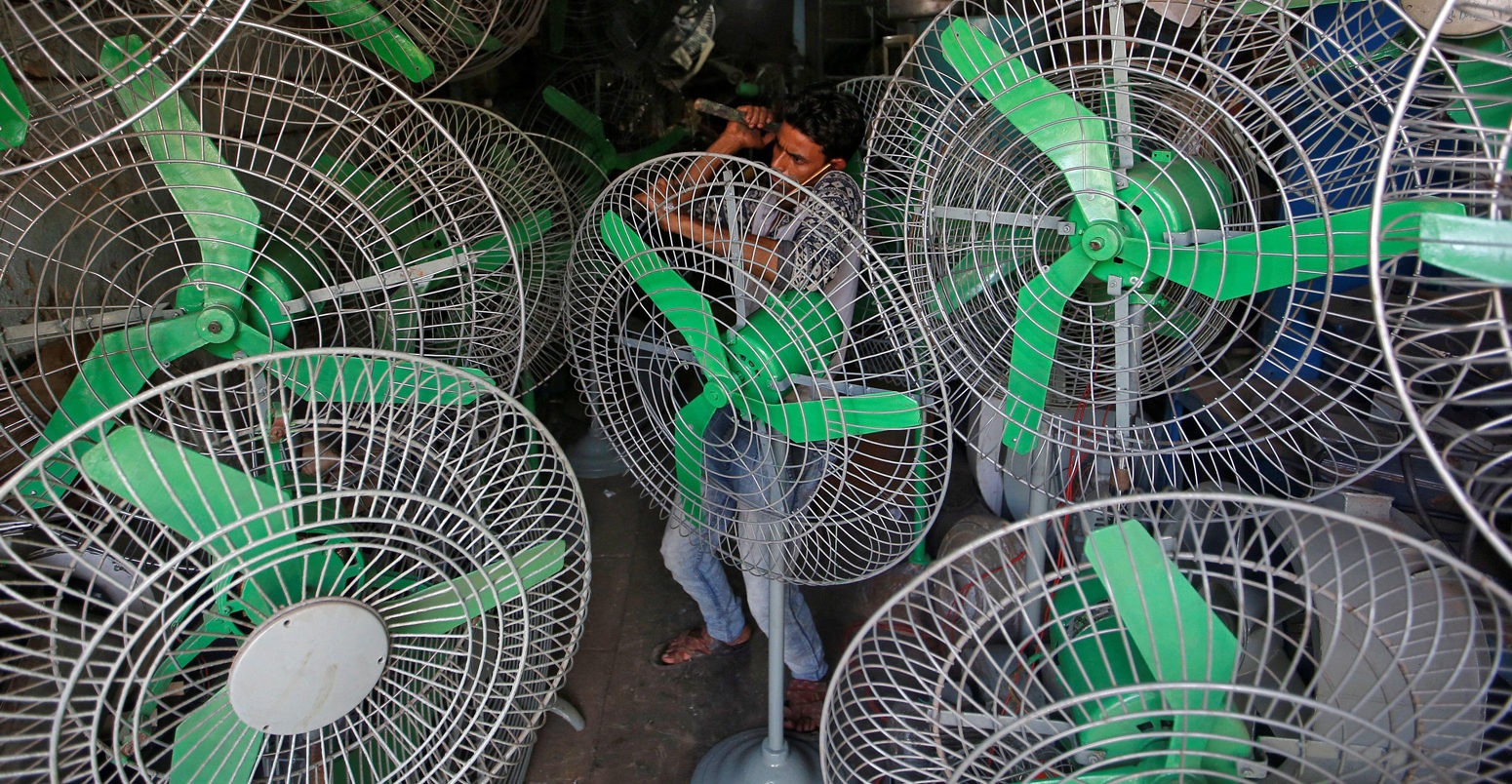
Guest post: How energy demand for cooling in India’s cities is changing

Dr Radhika Khosla
03.26.21
Dr Radhika Khosla
26.03.2021 | 12:22pmOver the past century, cooling technologies have fundamentally impacted the ways in which people interact with each other and their local environment.
The trajectory of cooling is now undergoing an extraordinary change. As the economies and populations of the hottest parts of the world grow, and global temperatures continue to rise, the demand for cooling for human comfort has the potential to drive one of the most substantial recent increases in energy and greenhouse gas emissions.
Understanding cooling demand growth and finding ways to shape its increase sustainably remains a complex task. In this regard, India is a very relevant case study. It ranks first among lower-middle income countries with an increasingly affluent middle class and it has the highest exposure to potential cooling needs.
While the magnitude of future cooling demand in India is increasingly known, little is understood about the dynamics of changing cooling patterns. How is cooling managed and what strategies do people use? How, when and why are people buying and using air conditioners (ACs)? Who is buying energy-efficient ACs? And is cooling consumption gendered?
In a new study, published in Environmental Research Letters, my coauthors and I provide answers to some of these fundamental cooling questions in one of the fastest and largest urbanising regions of the world.
Energy-intensive cooling
We selected Delhi – India’s capital territory – for our study as it is India’s highest electricity-consuming region and its trends provide insights for the rest of the country. Using a combination of existing datasets and new door-to-door surveys, we developed a sample of areas in Delhi with above-average AC penetration with a rare, near 50-50, split of AC and non-AC households.
Analysing the data, we unpack perceptions of thermal comfort, characterise the conditions under which households use ACs and examine what drives the purchase of energy-efficient cooling appliances.
We consider three types of cooling appliances in their respective order of uptake: fans, air coolers and ACs. Within the sample of households, we find that fans – which could be attached to the ceiling, table, wall or be free-standing – are the ubiquitous cooling device, with almost all households owning at least one.
As the Venn diagram below highlights, most homes have a combination of fans and coolers, but not ACs, while a third have fans and ACs, but not coolers. Forty-three per cent of households own one AC – most of which were newly bought in the previous two-to-three years – and 11% of homes have all the three cooling devices.
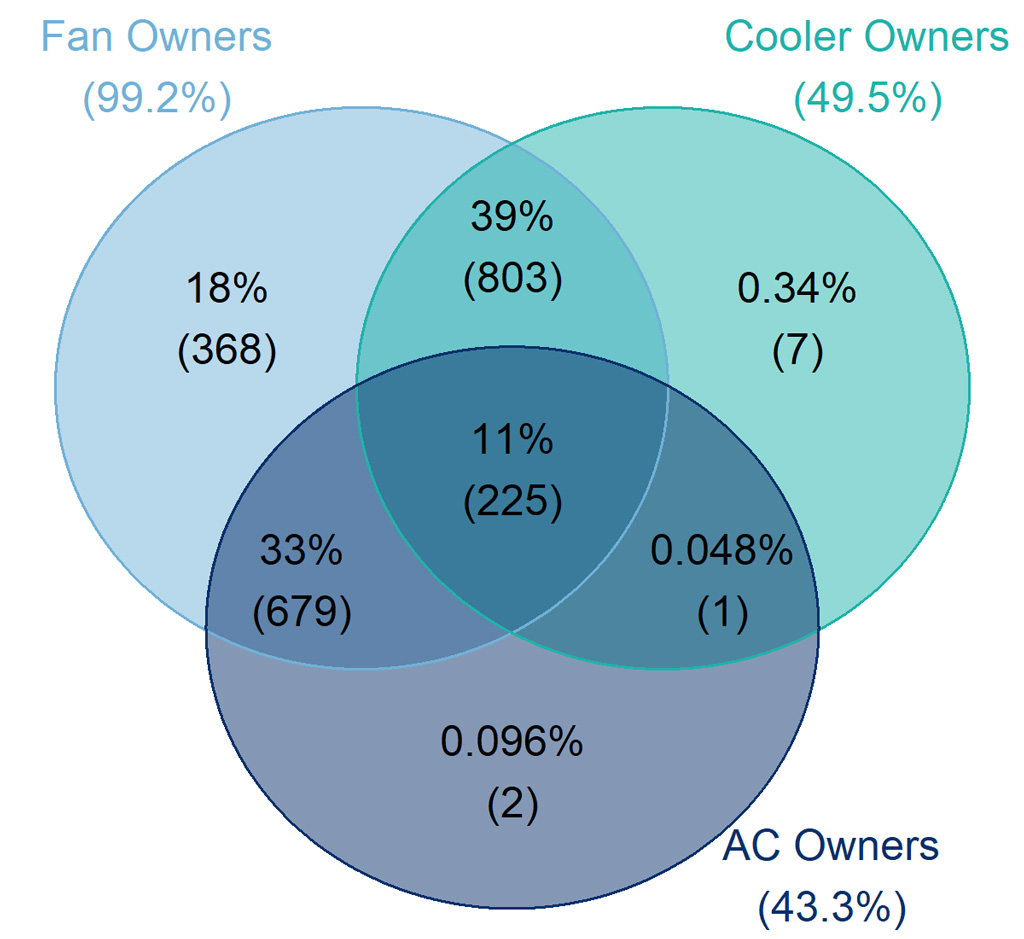
Approximately 18% of households in the same neighbourhoods own only a fan. The majority of non-AC owning households reported not switching to ACs due to the prohibitive costs of the appliance and of its related recurring costs, such as electricity bills and maintenance.
Clearly, interventions that rapidly scale up the energy efficiency of cooling appliances – at a speed that matches the fast rate of increasing AC and air-cooler penetration – will be essential to locking-in low-carbon thermal comfort.
Divided perceptions of cooling needs
Our data suggests that almost half the households set their AC thermostats between 24C and 26C, and less than a third prefer temperatures between 21C and 23C.
Overall, 24C is reported as the most preferred temperature setting for Delhi’s summer – where ambient temperatures are typically 28-35C. Notably, 24C is also the default setting for room ACs as mandated by India’s government in 2020.
The relatively large 5C range in the temperatures that households consider comfortable, even under the same weather conditions, is an important reminder of the varied perceptions of thermal comfort. In terms of cooling use, the majority of households use their AC for an average of three-to-six hours daily during peak summer months and the most common use of the AC is for sleeping.
The average number of hours of AC usage is 5.4 hours. Interestingly, this is much less than estimates in the national India Cooling Action Plan, which predicted usage at more than eight hours a day for six months of the year.
All of these findings are displayed in charts below, which shows average AC use (left), preferred temperature (middle) and timings of use (right).
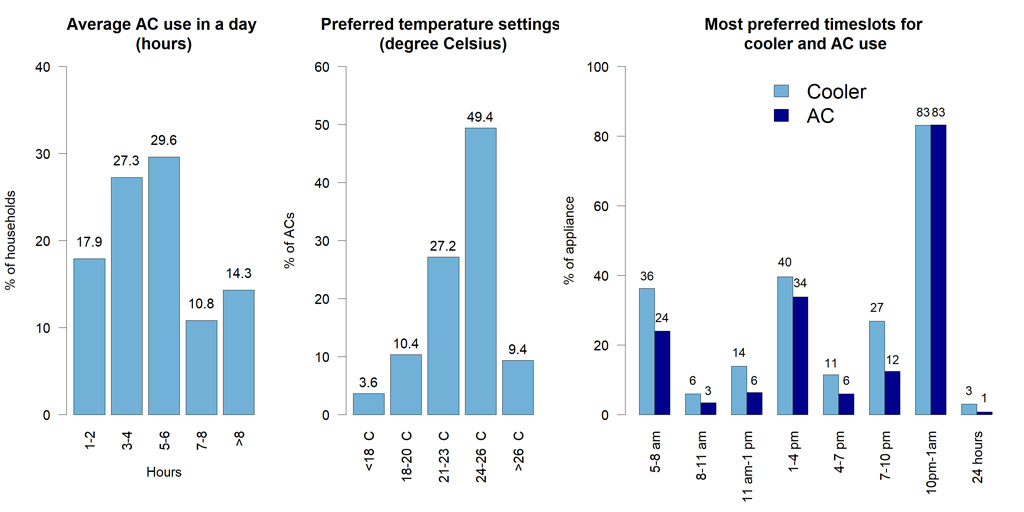
Predicting AC usage
Our data suggests that there are a number of significant factors that drive AC usage. These include residing above the ground floor (leading to 35% higher AC usage on average), living in apartments as opposed to houses (1.1 hours less AC usage on average) and having poor power supply (0.9 hours less usage on average).
Other socio-demographical factors are important, too, as well as thermal preferences, behaviours and awareness of energy efficiency. Houses with higher reported monthly incomes use the AC for longer. Whereas those with more second-hand ACs tend to use ACs for fewer hours, as do households with a higher proportion of seniors (aged 60 and above) and families who have not moved home for long periods.
The results also point to a key role for information and awareness of energy use. For example, those who are aware of the subsidised LED lighting bulbs scheme, own energy efficient fans and know the per-unit cost of electricity are predicted to have fewer hours of AC usage.
Furthermore, as the proportion of household members exposed to an AC at work or school grows from zero to one, we expect the average hours of AC usage to grow by 37%. This demonstrates the role of social networks and influence in rising cooling consumption.
Energy efficiency
A mid-efficiency range AC with a three-star rating is the most popular choice for households, given the higher price and low availability of more efficient four- and five-star ACs.
The chart below shows the breakdown of household ACs by energy efficiency rating.
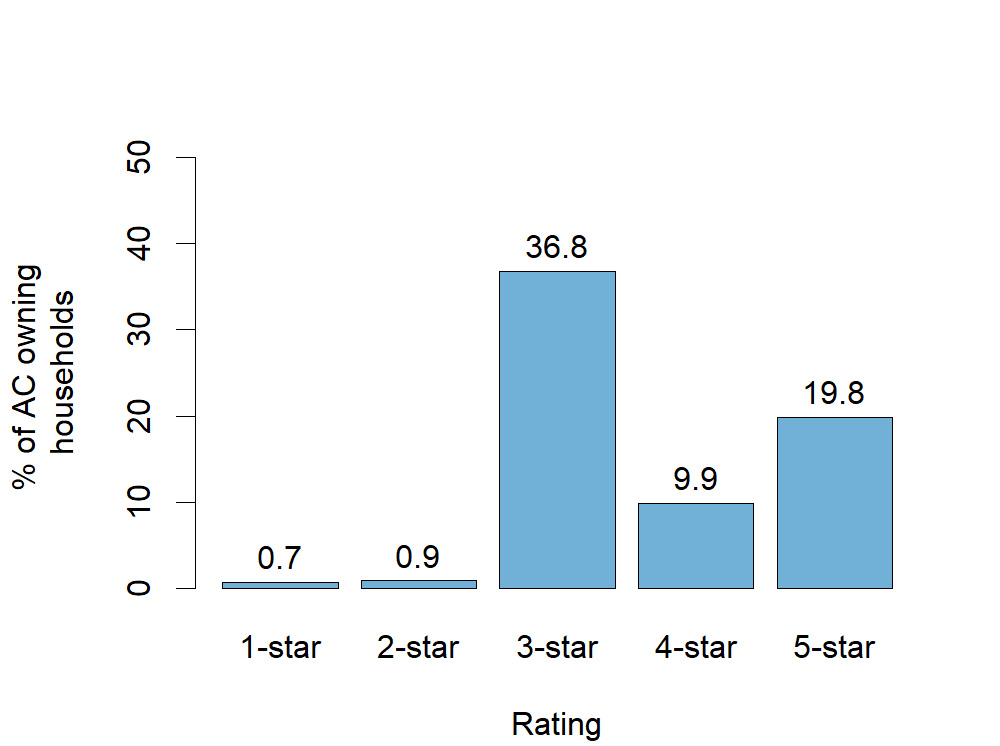
Beyond cost, efficient cooling investment decisions are also guided by awareness, AC characteristics and the scale of cooling needed. Those who own energy-efficient fans are predicted to have more efficient ACs.
Similarly, households that know the meaning of energy efficiency labels are predicted to have a higher-rated AC. However, less than 5% of households report energy efficiency as their reason for determining which kind of AC to buy. Instead, households give preference to AC features – such as having a remote or heating mode – over the technology brand and are subsequently predicted to make less efficient choices.
As the charts below illustrate, higher price and low availability are the two key factors that prevent people from buying a more efficient AC (left-hand chart). Energy and electricity bill savings and environmental consciousness are the most common reasons for choosing the more efficient options (right).
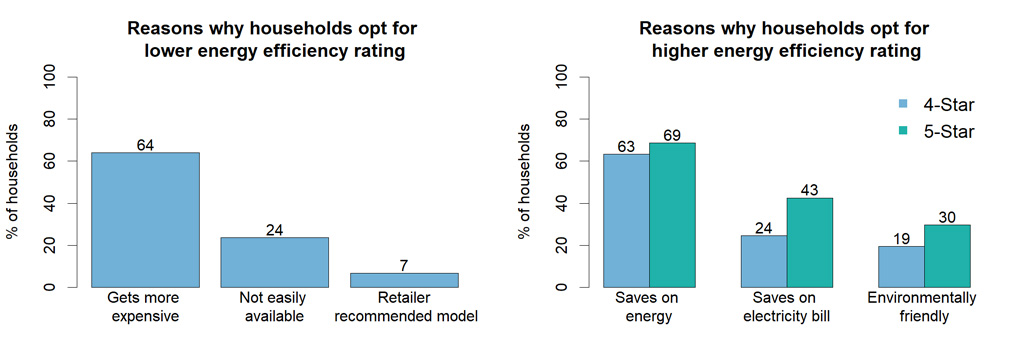
Women are less involved in energy decision-making
The decision to purchase an AC is found to be made by the head of household – who is usually male, middle-aged and employed – or by the head’s offspring. They are involved in all stages of the purchase process, from deciding which appliance to purchase to scouting for options.
In general, women were generally found to be less aware of appliance technicalities and of available energy-efficient schemes. Women also reported knowing the meaning of energy efficiency labels seen on refrigerators and ACs at a relatively lower rate compared to their male counterparts. Fewer women report being familiar with the specificities of their ACs, such as the brand, efficiency rating, capacity and warranty period.
This gap in appliance related know-how is further reflected in women being more likely to not have any preference in deciding which AC to purchase.
The chart below displays the findings for women (light blue bars) and men (dark blue).
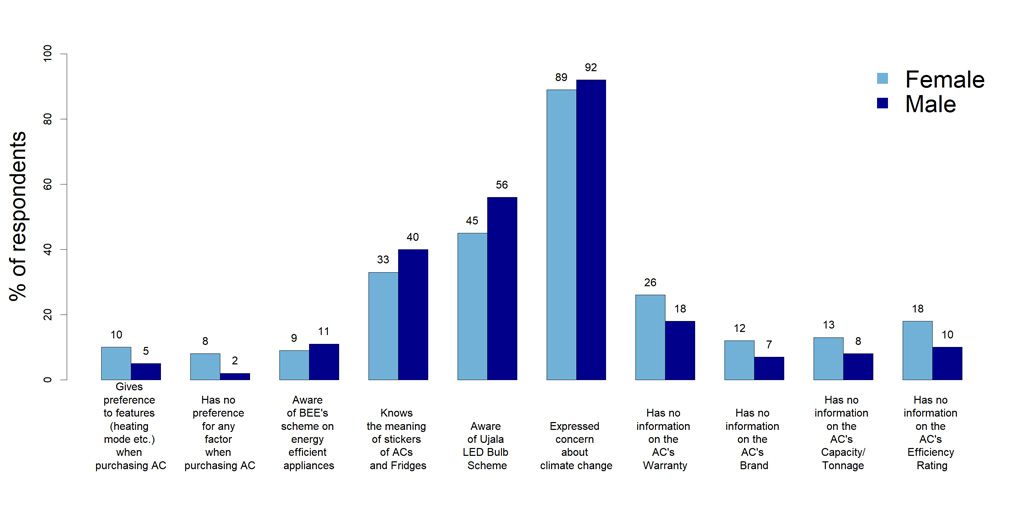
These results, which are different from those of other geographies where women play a much stronger environmental role, highlight how understanding the role of women in cooling energy decisions remains a key area of future work.
They also indicate that understanding the role of women in cooling energy decisions – as well as targeting and working with men and women differently – can be important to changing patterns of cooling consumption.
That is one example of how this case study can inform other fast-moving energy transitions.
A number of other recommendations for shaping the trajectory of cooling consumption emerge. For instance, the local retailer plays a vital role in influencing purchase decisions and provides the portfolio of efficient options available from which choices are made. Interventions targeting this point in the purchase process can be particularly helpful.
Cost is also important as the majority of the ACs are financed in instalments, making innovative financing mechanisms that promote efficient purchases and replacement of inefficient ACs likely to succeed.
Finally, recovering and promoting passive cooling alternatives from building design – such as shading and vegetation – also remain core to meeting future cooling needs in a low-carbon manner.
Khosla, R. et al. (2021) The what, why, and how of changing cooling energy consumption in India's urban households, Environmental Research Letters, doi:10.1088/1748-9326/abecbc

